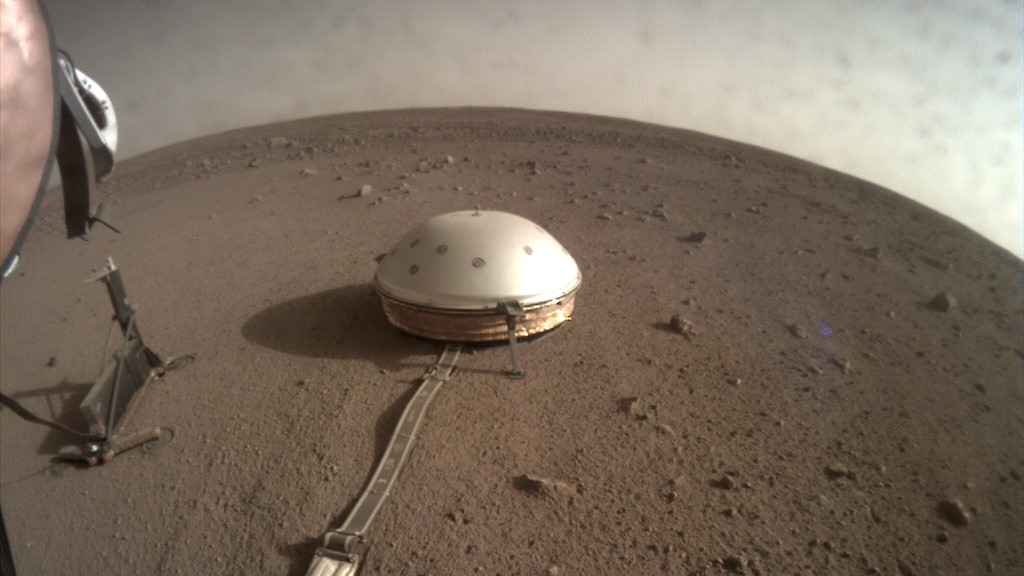Marsquake! NASA's InSight Lander Feels Its 1st Red Planet Tremor
Scientists just felt the Red Planet move under their feet — robotically from millions of miles away, on the stark surface of Mars.
On April 6, NASA's InSight lander sensed its first confirmed marsquake, a phenomenon scientists suspected, but couldn't confirm, occurred on the neighboring planet. Measuring the Martian equivalent of earthquakes, seismic waves traveling through the interior of the planet, was among the lander's key science goals.
"We've been waiting months for our first marsquake," Philippe Lognonné, the principal investigator for the seismometer instrument, said in a statement released by the French space agency, which runs the instrument with the national research center. "It's so exciting to finally have proof that Mars is still seismically active."
Related: NASA's InSight Mars Lander 'Hears' Martian Wind, a Cosmic First

Scientists never thought marsquakes would be as frequent as their terrestrial equivalents are because Mars doesn't sport the tectonic plates whose jostling interactions prompt many quakes here on Earth. But they suspected that the stress caused by the slow cooling of the body could trigger sporadic quakes as energy rippled through the planet's interior.
Now, they have their first proof that's the case. On April 6, the incredibly sensitive seismic detector the lander brought with it captured a tiny movement from the interior of the planet. The tentatively confirmed signal may have company from similar tremors measured on March 14, April 10 and April 11, but scientists aren't positive yet what triggered those incidents and can't confirm their shakes reflect interior activity.
The scientists behind the seismometer always knew they were facing a tricky challenge. The instrument had to be carefully designed if it was to succeed in picking up incredibly precise signals. It also needed protection from the wind, which is why the instrument itself is covered by a white dome, a shield that helps the instrument focus only on the interior of the planet. And because the scientists could only place a single detector, they needed to find a way to replicate the triangulation process that the seismic network on Earth permits naturally. The April 6 signal is the reward they've earned for that intricate design process.
Get the Space.com Newsletter
Breaking space news, the latest updates on rocket launches, skywatching events and more!
Although the scientists are excited by the detection, it won't help them tackle the ultimate goal of the InSight mission, which is to analyze the interior structure of Mars. This particular quake was not strong enough to produce the data they need for that analysis.
But the InSight team has other ways of gathering that data as well, since they weren't positive the planet had marsquakes to record. The instrument can also trace reverberations from meteorite strikes and from the self-hammering heat probe nicknamed the mole that is also part of the mission. (That instrument has floundered, possibly stuck against a rock, and scientists are working with a replica here on Earth to try to diagnose the issue.)
Scientists have long been fascinated by the idea of putting seismic instruments on other planets. NASA's Viking missions in the 1970s also carried seismometers, but the instruments were late additions and were simply plopped on the landers. From that height, they ended up being unable to pick up any meaningful signals.
InSight was able to place its seismometer directly on the planet's surface. That makes it more the successor of instruments placed on the moon's surface by astronauts during the Apollo program.
"InSight's first readings carry on the science that began with the Apollo missions," Bruce Banerdt, a geophysicist at NASA's Jet Propulsion Laboratory in California and principal investigator on the InSight mission, said in the same statement. "We've been collecting background noise up until now, but this first event officially kicks off a new field: Martian seismology."
- Mars InSight in Photos: NASA's Mission to Probe Core of the Red Planet
- Journey to the Center of the Red Planet: NASA's InSight Lander to Reveal the Secrets Inside Mars
- Robot 'Mole' on Mars Begins Digging Into Red Planet This Week
Email Meghan Bartels at mbartels@space.com or follow her @meghanbartels. Follow us on Twitter @Spacedotcom and on Facebook.
Join our Space Forums to keep talking space on the latest missions, night sky and more! And if you have a news tip, correction or comment, let us know at: community@space.com.

Meghan is a senior writer at Space.com and has more than five years' experience as a science journalist based in New York City. She joined Space.com in July 2018, with previous writing published in outlets including Newsweek and Audubon. Meghan earned an MA in science journalism from New York University and a BA in classics from Georgetown University, and in her free time she enjoys reading and visiting museums. Follow her on Twitter at @meghanbartels.









